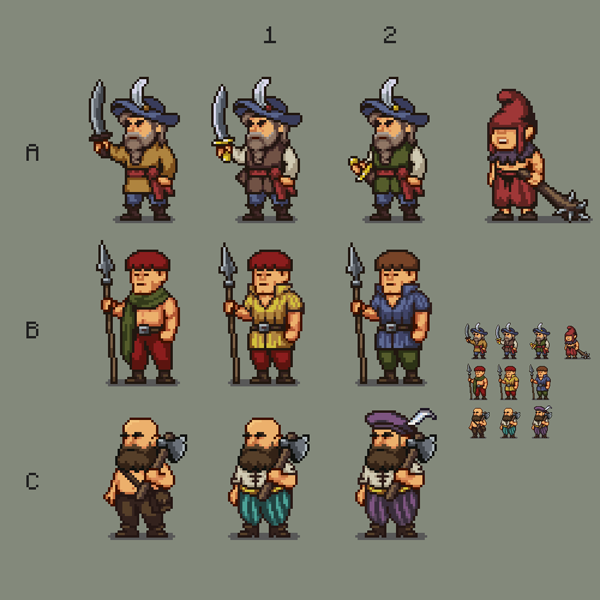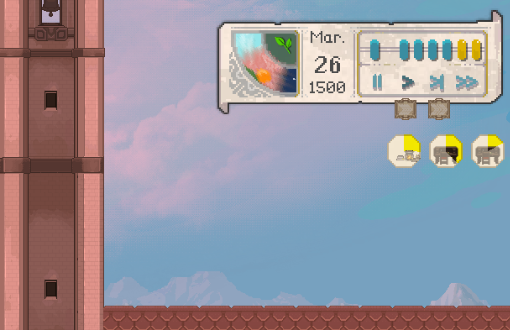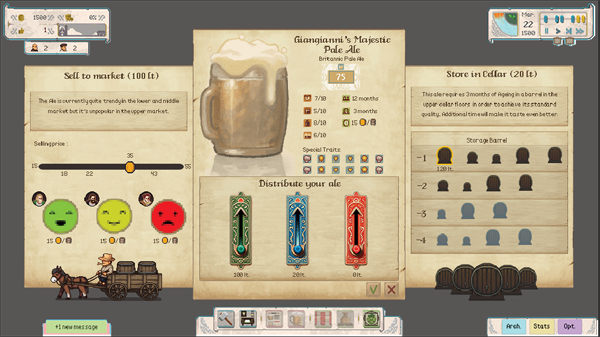We do talk about every week being a challenge and still not backing down, but this week was quite demanding across the board.
Things that you won't hear about in today's Something's Brewing include our work on Tasks both in terms of content and their backend (think of them as linear and non-linear mini-quests), the incredibly detailed work on tech trees that gave Emiliano's game dev brain a run for its money, and a lot of work on the UI scenes that are still being designed and are so early in their WIP cycle we can't show anything meaningful of them, like the Merchant and his Stall rework.
But what about today's highlights? The things we really enjoyed working on this week? Well, stay a while and listen!
-- Bandits knocking at your door...
As we mentioned a couple of weeks ago, the Bandits have been on their way, coming through the forests and mountains surrounding the Abbey. Don't let the name fool you, their addition to the mix will allow for quite a few pleasant mechanics that will enrich both gameplay and story!
And if you were wondering, yes, they are based on very real bandits and brigands that plagued most of Europe (west, east, north, and south!), during the time. Varying degrees of aggression aside (some of them would only extort, others... were not very fun to come across), we will still be designing them as close to the rest of the characters in Ale Abbey as possible; which means cute and non-threatening.
So... expect them to pop up "asking" for a few liters of ale, keep them happy by meeting their demands, and you might find that resources (and maybe even Florins) find their way to the Abbey intact in the next couple of in-game weeks :p

These initial models look good, but consider them WIP, with many things yet to be decided; color palettes, paraphernalia, and of course the way they will plague your monastery in case things don't go their way!
-- More QoL changes in the main UI
UI is the gift that never stops giving. We can think of many ways to make it shinier, cooler, and information-rich, but this limitless amount of possibilities can easily drop us into the black hole of never truly finishing any part of it (AKA feature creep).
Having said that though, there are features we simply can't ignore since they increase in-game Quality of Life dramatically. One such feature is something we have been testing this week, the addition of an extra notification layer, one with icons that represent tasks happening in real-time, as well as timers superimposed on them for a more efficient glance at the monastery's activities.
If done properly - and we aim to do so - we can see how these can up the game for quite a few tycoon lovers out there. Management aficionados, rejoice!

-- What to do with all this beer?
We expect you to brew a lot in Ale Abbey. And we want to believe you already have a good understanding of how all that ale will be used. Be it the Cellars or the Markets, when an ale is ready, you get to decide how much and where it goes.
As a quick refresher, the Cellars will be used to further ferment certain ale styles, store your ale for future trading or upcoming tasks, or hold on to the beer for internal consumption (gotta keep those Monks and Nuns happy and eager to brew!). The Markets (because we are talking about Low-level, Medium-level, and High-level markets here), are where your beer is directly sold to the masses in hopes it will bring your monastery fame and Florins.
In dealing with this question of planning, ("When and how do we deal with this brew?") we want you to have a firm grasp of all the parameters tied to it: how will you price the beer? how is this beer expected to do in each market? is a style in season yet? do you have enough barrels to store your beers in the Cellar? do you have enough Cellar space? And these are but a few of the questions.
So, once again, we are trying to take a complex decision-making process and use a simple and "clean" UI scene to oversimplify it. All the information present, easy on the eyes, easy on the mind. We have been testing a few ideas and we have already reached a good foundation we believe we can work on.
Do click for a larger version. Oh, and if you have any ideas or feedback, now is the time!
-- Cold Crashing at home
Continuing from our discussion about the pros and cons of Cold Crashing last week, once you decide to go for it, what can you do to cold crash from the comfort of your home?
- Primary Fermentation Completion: Ensure that primary fermentation is complete before cold crashing. Depending on the beer style and yeast strain used, this usually takes about one to two weeks. You can check the gravity readings with a hydrometer to confirm fermentation is finished.
- Temperature Control: Lower the temperature of your fermenter gradually. Aim to lower it to near-freezing temperatures, typically between 0-4°C. If you actually have the tools for it, use a temperature-controlled environment such as a dedicated fermentation chamber or a refrigerator with a temperature controller.
- Time: Allow sufficient time for cold crashing to take effect. It typically takes a couple of days to a week for the beer to clarify, depending on factors such as beer style, yeast strain, and the amount of sediment present.
- Cover and Seal: Just because you're dropping its temperature, that doesn't mean your beer is safe from contaminants. Cover the fermenter to prevent contaminants from entering during the cold-crushing process. Any airtight lid you can get your hands on, should be enough.
- Avoid Oxygen Exposure: Oxygen can negatively impact the flavor and stability of the beer. Ensure that the fermenter is sealed tightly and avoid unnecessary agitation.
- Racking: Consider racking the beer to a secondary fermenter or a keg before cold crashing to further minimize sediment and yeast contact. Although optional, if done safely, this step can help produce a clearer final product.
- Patience: Be patient and avoid rushing the cold crashing process. Allowing enough time for the beer to clarify will result in a better-looking and better-tasting final product.
If a crystal clear beer is what you're looking for, try these and share some pictures ;)
Enjoy your weekend responsibly, and join us next week for some more Ale Abbey news!
-- Hammer & Ravens
Craving for more Ale Abbey? Or maybe you want to chat with the team and our community? Find us on:







Congratulations on the progress! Keep it up!
thank you very much!!!